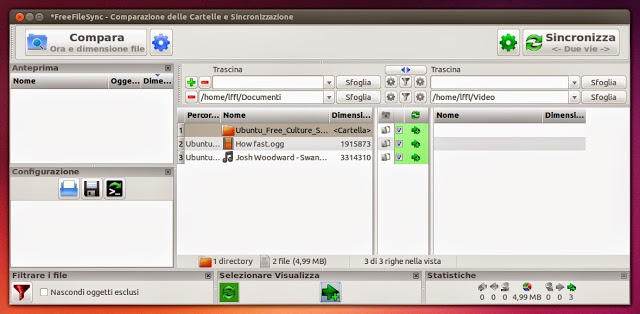

- #FREEFILESYNC UBUNTU HOW TO#
- #FREEFILESYNC UBUNTU INSTALL#
- #FREEFILESYNC UBUNTU WINDOWS 10#
- #FREEFILESYNC UBUNTU PASSWORD#
- #FREEFILESYNC UBUNTU PC#
#FREEFILESYNC UBUNTU INSTALL#
Is it even possible without GUI? If not - which lightweight GUI should I pick to install on the server? To be honest, this is server and the best option would be to avoid the GUI. Create a task to start and run the task without user interaction as root when system starts, each 15 minutes. Convert ffs_batch to ffs_real (if needed).ģ.
#FREEFILESYNC UBUNTU PASSWORD#
Create a ffs_batch file from scratch with desired synchronization options and e-mail notification.įor this would also be good to "cache" somewhere logon name and password for Windows share (e.g.

What I need is to create a task on Ubuntu Server 20.04 LTS machine without gui to synchronize files between network share (Windows Server 2019, ActiveDirectory member) and Ubuntu Server 20.04 LTS without GUI, only CLI. This makes sure the monitored folders are not in heavy use when starting a synchronization.I was trying to find anything about the topic and what I was able to dig out was Crontab definition for existing ffs_batch file in Ubuntu.
#FREEFILESYNC UBUNTU HOW TO#
In this tutorial, we will cover how to install FreeFileSync on Ubuntu 22.04 step-by-step. It’s a multi-platform tool that is available for Windows, Linux, and Mac. Each time a file or folder is created/updated/deleted in the monitored directories or their sub directories, RealTimeSync waits until a user-configurable idle time has passed in which no further changes were detected, and then runs the command line. FreeFileSync is an open-source file synchronization & backup tool that helps in synchronizing files across folders and various devices and keeping your data updated. RealTimeSync receives change notifications directly from the operating system in order to avoid the overhead of repeatedly polling for changes. This is an excerpt from the FreeFileSync manual, hope it further clarifies this matter: If you do not make any further changes this time in that predefined delay interval, sync process will run in the background and synchronize the file with remote drive/partition/folder. Delay timer resets, and starts counting again to 10. Delay timer starts, and starts counting to 10: 1, 2, 3, 4… But, 5 seconds later you do another change and save the file again. In simple terms, let us consider an example: you work on a file, then you save it. Then the new cycle runs, but if there are no changes made, there will be nothing to sync.

In this article I will show you how to install FreeFileSync 5.18 on Ubuntu 13.04 Raring Ringtail, Ubuntu 12. The latest version available is FreeFileSync 5.18. Process monitors changes, and when the timer reaches predefined delay without any further changes activities, it runs the sync procedure automatically in the background. As you may know, FreeFileSync is an open-source software, for syncronizing files and folders.It has a simple UI and it should offer good performance. while you work on heavy files on the main drive/partition/folder. Sync delay only defines actual synchronization frequency to spare your CPU/HDD/SSD/Network resources and avoid doing double work e.g.
#FREEFILESYNC UBUNTU PC#
RealTimeSync process continuously runs in the background, yes it starts automatically when PC starts, and it also continues to run afterwards independently. Hi, good question, this is how we understand this feature: Regarding the delay time set in RealTimeSync, with an example of 10 seconds, does it sync whenever there’s an idle time of 10 seconds, meaning another sync will auto run after an elapse of 20 seconds and another sync will auto run again after an elapse of 30 seconds (and this keeps on going)? Or does the sync only happens once after a PC startup and will not happen again until the next PC startup? In another words, this is simply a backup file of main program configuration. Of course, *.ffs_gui is straightforward to explain: it is simply a settings file of all the options you set in the main program (app) windows with graphical user interface (hence, _gui part), containing folder pairs, sync modes, exclusion list etc. FreeFileSync – File Types (Extensions) ExplainedįreeFileSync has a little bit convoluted procedure for creating real-time synchronization between folders,īut first let’s learn one important thing which will help us better understand and go throughout the tutorial later.įreeFileSync can generate 3 different kind of files (extensions):Īll 3 extensions have different use cases. It will look extremely complicated and convoluted, but once you go through, it’ll become a routine task to set up later.
#FREEFILESYNC UBUNTU WINDOWS 10#
In this tutorial we’ll show you how to utilize real time sync / backup on Windows 10 operating system in just a few relatively simple steps.


 0 kommentar(er)
0 kommentar(er)
